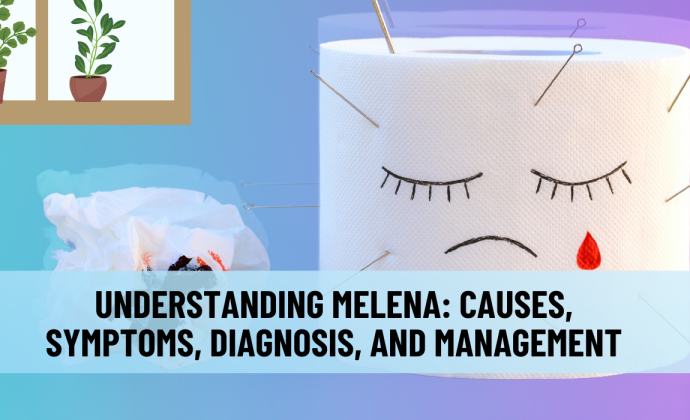
Understanding Melena: Causes, Symptoms, Diagnosis, and Management
Melena is a medical term that refers to the condition in which stools are black and sticky due to bleeding in the digestive tract. Bleeding typically occurs in the upper gastrointestinal tract, including the mouth, esophagus, stomach, and duodenum (the first part of the small intestine). However, in some cases, bleeding in the ascending colon (the first part of the large intestine) can also result in melena.
(Image source: Medical News Today, 2023)
Melena is different from hematochezia, which refers to fresh blood in the stool, causing it to appear bright red or maroon. In hematochezia, the blood originates from the lower gastrointestinal tract, often from bleeding in the rectum or anus, such as from hemorrhoids.
Causes of Melena
Melena occurs due to damage to the lining of the upper gastrointestinal tract, swelling of blood vessels, or bleeding disorders caused by various conditions such as:
– Peptic ulcer, characterized by open sores in the stomach or small intestine. Peptic ulcers can be caused by Helicobacter pylori infection, chronic use of aspirin, or nonsteroidal anti-inflammatory drugs (NSAIDs).
– Damage to the gastrointestinal tract, such as:
1. Mallory-Weiss tears, which are tears or wounds that occur in the lower esophagus, often due to excessive vomiting.
2. Excessive production of stomach acid. Gastroesophageal reflux disease (GERD) can cause severe inflammation in the esophagus known as erosive esophagitis, leading to ulcers and bleeding.
3. Formation of tumors, including adenocarcinoma, squamous cell carcinoma, carcinoid tumors, and lipomas.
– Swelling of blood vessels or varices, which can also cause bleeding in the upper digestive tract.
Symptoms of Melena
Melena is characterized by several symptoms, including:
– Black, tarry stools
– Sticky stool texture
– Foul-smelling stools
– Abdominal pain
– Vomiting blood or hematemesis
Diagnosis of Melena
Doctors will conduct a medical history review and physical examination. They may also perform various tests to determine the cause of melena, such as:
– Stool tests, blood tests, and breath tests to check for signs of infection, including H. pylori infection.
– Esophagogastroduodenoscopy (EGD), a procedure used to examine the upper gastrointestinal tract, identify the source of bleeding, and take tissue samples for testing.
– X-rays or CT scans, which can also help doctors identify tears, obstructions, or tumors causing melena.
– Angiography, a test used to locate and stop bleeding from arteries.
Management of Melena
– Medications: Proton pump inhibitors (PPIs), such as esomeprazole or pantoprazole, help reduce acid production. PPIs, along with antibiotics, may also be used to treat H. pylori infection.
– Endoscopy: Endoscopic procedures are performed to treat the underlying cause of bleeding.
– Blood transfusion: Blood transfusion is performed if the patient has lost a significant amount of blood.
– Surgery: Surgery may be necessary to repair tears in the stomach or intestinal lining or to remove blockages or tumors in the digestive tract.
This article has been reviewed by Virlly Nanda Muzellina, MD Consultant of Gastroenterohepatology
Source:
Osmosis from Elsevier. Melena: What is it, Causes, Symptoms, Bleeding, Treatment, and More. Retrivied from: https://www.osmosis.org/answers/melena.
IDN Medis. Melena: Penyebab – Gejala dan Cara Mengobati. Retrivied from: https://idnmedis.com/melena#idnmedis_ref Kompas Health. (2021). Melena. Retrivied from: https://health.kompas.com/penyakit/read/2021/11/15/141200168/melena#google_vignette
Images source:
Viktoriia M1 (ilustration on cover)
luciafoxdesign (ilustration on cover)
Medical News Today. 8 Causes of yellow stool: What it means, treatment, and more. Retrivied from: https://www.medicalnewstoday.com/articles/323147





 Users Today : 125
Users Today : 125 Total views : 2089748
Total views : 2089748 Who's Online : 6
Who's Online : 6